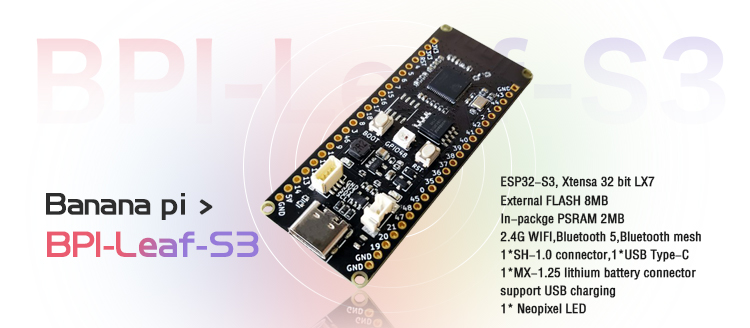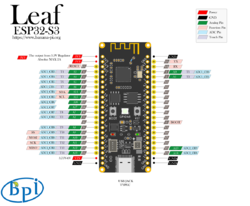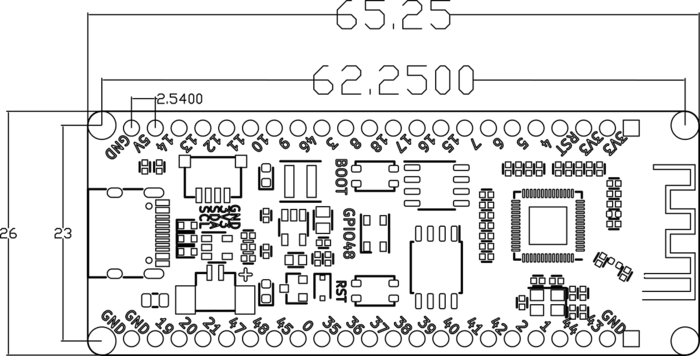Difference between revisions of "BPI-Leaf-S3"
(→Hardware Spec) |
(→Introduction) |
||
| Line 11: | Line 11: | ||
[[File:BPI-Leaf-S3_banner.jpg]] | [[File:BPI-Leaf-S3_banner.jpg]] | ||
| − | The Banana Pi Leaf series | + | The Banana Pi Leaf is a series of low-powered microcontrollers designed for IoT development. |
| − | |||
| − | |||
It supports 2.4 GHz Wi-Fi and Bluetooth® LE dual-mode wireless communication, the peripheral is compatible with low-power hardware design, and the power consumption is only 10uA in deep sleep mode. | It supports 2.4 GHz Wi-Fi and Bluetooth® LE dual-mode wireless communication, the peripheral is compatible with low-power hardware design, and the power consumption is only 10uA in deep sleep mode. | ||
| − | The main controller supports two power supply | + | The main controller supports two power supply inputs: USB and external 3.7V lithium battery, both can be interchangable freely. The battery could also be charged while USB is plugged in. Compact size, various interface, easy to use, and can be directly applied to low-power IoT projects. |
| − | In terms of programming, Leaf-S3 | + | In terms of programming, the Leaf-S3 supports ESP-IDF, Arduino, micropython and other methods. |
| − | + | The IO pins on BPI-Leaf-S3 are identical to the Espressif ESP32-S3-DevKitC-1, developers can add peripherals that are supported by DevKitC-1 onto the BPI-Leaf-S3, and can also combine it onto a breadboard. | |
== Key Features == | == Key Features == | ||
Revision as of 04:17, 16 March 2022
Contents
Introduction
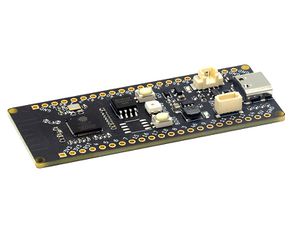
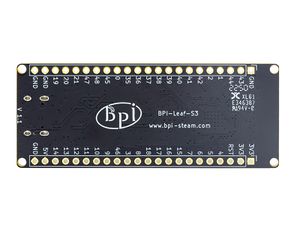
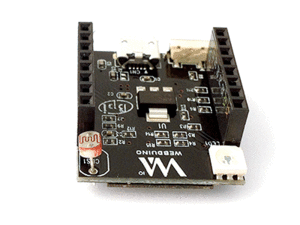
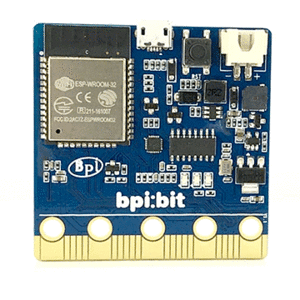
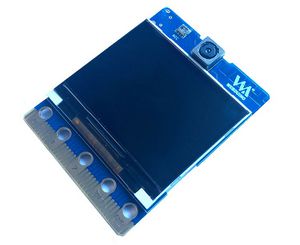
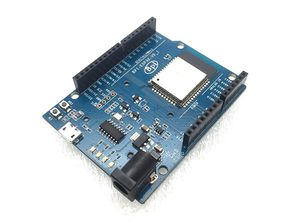
The Banana Pi Leaf is a series of low-powered microcontrollers designed for IoT development.
It supports 2.4 GHz Wi-Fi and Bluetooth® LE dual-mode wireless communication, the peripheral is compatible with low-power hardware design, and the power consumption is only 10uA in deep sleep mode.
The main controller supports two power supply inputs: USB and external 3.7V lithium battery, both can be interchangable freely. The battery could also be charged while USB is plugged in. Compact size, various interface, easy to use, and can be directly applied to low-power IoT projects.
In terms of programming, the Leaf-S3 supports ESP-IDF, Arduino, micropython and other methods.
The IO pins on BPI-Leaf-S3 are identical to the Espressif ESP32-S3-DevKitC-1, developers can add peripherals that are supported by DevKitC-1 onto the BPI-Leaf-S3, and can also combine it onto a breadboard.
Key Features
- ESP32-S3,Xtensa® 32 bit LX7
- External PSRAM , FLASH
- Ultra-low power 10uA
- 2.4G WIFI ,Bluetooth 5 ,Bluetooth mesh
- GPIO , ADC , TOUCH , PWM , I2C , SPI , RMT , I2S , UART , LCD,CAMERA ,USB , JTAG
- 1* 4pin I2C connector
- 1 * USB Type-C
- 1 * 2pin battery connector,support charging
- 1 * Neopixel LED
Espressif ESP32-S3
ESP32-S3 is a dual-core XTensa LX7 MCU, capable of running at 240 MHz. Apart from its 512 KB of internal SRAM, it also comes with integrated 2.4 GHz, 802.11 b/g/n Wi-Fi and Bluetooth 5 (LE) connectivity that provides long-range support. It has 45 programmable GPIOs and supports a rich set of peripherals. Compared with ESP32, it supports larger, high-speed octal SPI flash, and PSRAM with configurable data and instruction cache.
What follows is a description of the most important features of ESP32-S3.
- Wi-Fi + Bluetooth 5 (LE) Wireless Connectivity: ESP32-S3 supports a 2.4 GHz Wi-Fi (802.11 b/g/n) with 40 MHz of bandwidth support. The Bluetooth Low Energy subsystem supports long range through Coded PHY and advertisement extension. It also supports higher transmission speed and data throughput, with 2 Mbps PHY. Both Wi-Fi and BLE have superior RF performance that is maintained even at high temperatures.
- AI Acceleration Support: ESP32-S3 has additional support for vector instructions in the MCU, which provides acceleration for neural network computing and signal processing workloads. The software libraries for the above-mentioned optimized functions will become available very soon, in the form of updates to ESP-WHO and ESP-Skainet.
- Rich Set of IO Peripherals: ESP32-S3 has 44 programmable GPIOs, namely 10 more GPIOs than those of ESP32. ESP32-S3 supports all the commonly-used peripherals, such as SPI, I2S, I2C, PWM, RMT, ADC and UART, SD/MMC host and TWAITM. In total, 14 GPIOs can be configured as capacitive touch input for HMI applications. Apart from all these peripherals, however, ESP32-S3 is also equipped with an ultra-low-power (ULP) core that supports multiple low-power modes in a variety of such use-cases.
- Security:ESP32-S3 provides all the necessary security requirements for building securely connected devices, without requiring any external components. It supports AES-XTS-based flash encryption and RSA-based secure boot. In addition, ESP32-S3 has a digital signature peripheral and an HMAC module, which provide functionality that is similar to the hardware secure element, thus protecting the private or symmetric key from software attacks and identity theft. ESP32-S3 also has a “World Controller” peripheral that provides two fully-isolated execution environments, which enable the implementation of a trusted-execution environment or a privilege-separation scheme.
Hardware
Hardware sketch map
Hardware Spec
| BPI-Leaf-S3 Spec | |
|---|---|
| SoC | ESP32-S3,Xtensa® dual-core 32-bit LX7 microprocessor |
| Clock Frequency | 240MHz MAX |
| Operating Temperature | -40℃~+85℃ |
| Internal ROM | 384 KB |
| Internal SRAM | 320 KB |
| External FLASH ROM | 8MB |
| External PSRAM | 8MB |
| WIFI | IEEE 802.11 b/g/n ,2.4Ghz,150Mbps |
| Bluetooth | Bluetooth 5 ,Bluetooth mesh |
| GPIO | BPI-Leaf-S3 has led out 36 available gpios |
| ADC | 2 × 12-bit SAR ADCs, up to 20 channels |
| Touch Sensor | 14 |
| SPI | 4 |
| I2C | 2 |
| I2S | 2 |
| LCD | 1 × LCD interface (8-bit ~16-bit parallel RGB, I8080 and MOTO6800) |
| CAMERA | 1 × DVP 8-bit ~16-bit camera interface |
| UART | 3 |
| PWM | 8 channels 14 bits |
| MCPWM | 2 |
| USB | 1 × full-speed USB OTG,female Type-C socket |
| USB Serial/JTAG controller | 1,CDC-ACM ,JTAG |
| Temperature Sensor | 1,ranging from -20 °C to 110 °C |
| SD/MMC | 1 × SDIO host controller with 2 slots,SD 3.0,SD 3.01,SDIO 3.0,CE-ATA 1.1,MMC 4.41,eMMC 4.5,eMMC 4.51 |
| TWAI® controller | 1 ,compatible with ISO 11898-1 (CAN Specification 2.0) |
| General DMA controller (GDMA) | 5 transmit channels and 5 receive channels |
| RMT | 4 TX channels,4RX channels.Eight channels share a 384 x 32-bit RAM |
| Pulse Count Controller | 4 independent pulse counters (units).Each unit consists of two independent channels |
| Timers | 4 × 54-bit general-purpose timers. 1 × 52-bit system timer. 3 × watchdog timers |
| External crystal oscillator | 40Mhz |
| RTC and LowPower Management | Power Management Unit (PMU) + Ultra-Low-Power Coprocessor(ULP) |
| Deep-sleep consumption current | 10uA |
| Operating Voltage | 3.3V |
| Input Voltage | 3.3V~5.5V |
| Maximum discharge current | [email protected] LDO |
| USB charge | Support |
| Maximum charging current | 500mA |
| Neopixel LED | 1 |
Hardware Dimensions
| BPI-Leaf-S3 Dimensions | |
|---|---|
| Pin spacing | 2.54mm |
| Mounting hole spacing | 23mm/ 62.25mm |
| Mounting hole size | bore 2mm/outside 3mm |
| Motherboard size | 26 × 65.25(mm)/1.02 x 2.57(inches) |
| board thickness | 1.2mm |
The pin spacing is breadboard compatible for easy application debugging.
Peripheral Pin Configurations
| BPI-Leaf-S3 GPIO Pin define | ||
|---|---|---|
| Peripheral Interface | Signal | Pin |
| ADC | ADC1_CH0~9 | GPIO 1~10 |
| ADC2_CH0~9 | GPIO 11~20 | |
| Touch sensor | TOUCH1~14 | GPIO 1~14 |
| JTAG | MTCK | GPIO 39 |
| MTDO | GPIO 40 | |
| MTDI | GPIO 41 | |
| MTMS | GPIO 42 | |
| UART | The pins are assigned by default, and can be redefined to any GPIO | |
| U0RXD_in | GPIO 44 | |
| U0CTS_in | GPIO 16 | |
| U0DSR_in | any GPIO | |
| U0TXD_out | GPIO43 | |
| U0RTS_out | GPIO 15 | |
| U0DTR_out | any GPIO | |
| U1RXD_in | GPIO 18 | |
| U1CTS_in | GPIO 20 | |
| U1DSR_in | any GPIO | |
| U1TXD_out | GPIO 17 | |
| U1RTS_out | GPIO 19 | |
| U1DTR_out | any GPIO | |
| U2 | any GPIO | |
| I2C | any GPIO | |
| PWM | any GPIO | |
| I2S | any GPIO | |
| LCD | any GPIO | |
| CAMERA | any GPIO | |
| RMT | any GPIO | |
| SPI0/1 | Used for FLASH and PSRAM | |
| SPI2/3 | any GPIO | |
| Pulse counter | any GPIO | |
| USB OTG | D- | GPIO 19(on-chip PHY) |
| D+ | GPIO 20(on-chip PHY) | |
| VP | GPIO 42(external PHY) | |
| VM | GPIO 41(external PHY) | |
| RCV | GPIO21(external PHY) | |
| OEN | GPIO 40(external PHY) | |
| VPO | GPIO 39(external PHY) | |
| VMO | GPIO38(external PHY) | |
| USB Serial/JTAG | D- | GPIO 19(on-chip PHY) |
| D+ | GPIO 20(on-chip PHY) | |
| VP | GPIO 42(external PHY) | |
| VM | GPIO 41(external PHY) | |
| OEN | GPIO 40(external PHY) | |
| VPO | GPIO 39(external PHY) | |
| VMO | GPIO38(external PHY) | |
| SD/MMC | any GPIO | |
| MCPWM | any GPIO | |
| TWAI | any GPIO | |
| Neopixel LED | GPIO 48 | |
Software
MicroPython development
Regardless of whether there is a programming foundation or not, MicroPython is definitely far less difficult to get started than other MCU programming languages.
Its code is easy to read, and it has rich resources accumulated over the years in the open source community.
Just like Python, it has strong vitality and application value.
